The cool of a grey autumn afternoon envelops the forest-clad hills surrounding the quaint ski resort of Saint-Sauveur about an hour north of Montréal in the French-speaking state of Québec, Canada. Seventeen humans enter an enclosure of about 20 m x 40 m. A little later they are voluntarily joined by seven horses. There are two entrances to the enclosure but no gates. The horses are not restricted by any tack and are at liberty to leave if they please. Instead, they mingle with the humans. Unrestrained, horses and humans seek contact with each other. Here and there an interspecies connection is made. The dance begins. And I find myself at the interface of horse-human interaction. It is magical.
Nevzorov Haute Ecole
On Saturday 22 and Sunday 23 September Vicki and I attended an international Nevzorov Haute Ecole (NHE) seminar hosted and organised by the sole NHE International representative, Michael Bevilacqua, and the dean of the NHE international online school, Cloé Lacroix. We attended as invited guests, for which we are especially grateful.
Awake for 18 hours without a break, Vicki and I attend a meet-and-greet cocktail party on Friday evening and there I finally meet a man who has done more than any other to earn my respect in relation to horses. A little shy of 50, Michael Bevilacqua has only been involved with horses since the age of 37. Yet in 2005 he entered the world of NHE and was shortly afterwards appointed to serve as its sole international representative.
So what is NHE and what does it stand for? Something hauntingly beautiful and simultaneously something overpoweringly oppressive. Picture, if you will, a short-cropped modern version of Rasputin. Highly eloquent, stylish and obsessed with the personification of totally unbridled horsemanship, Alexander Nevzorov has amazed the horse world with his ability to train horses for and to lead them in haute ecole exercises performed at arguably a more advanced level than the four leading classical dressage schools of the world (The Royal Andalusian School of Equestrian Art in Jerez de Frontera, Spain, The Spanish School of Riding in Vienna, Austria, the Cadre Noir in Saumur, France, and the Portuguese School of Equestrian Art in Lisbon, Portugal), more advanced if only in that he has managed to do so by relying entirely on the horse’s willing cooperation.
Whereas the gentlemen of those illustrious schools rely on bits, bridles, spurs and/or other restraints and instruments of force and violence to achieve results, making their horses do what, how and when they, the humans, please, Nevzorov relies solely on a thin cord around the lower part of his horse’s neck – the cordeo – to guide the horse and, more importantly, on communication and understanding to command and hold its attention. Without such communication and understanding he has nothing, for the horse is unrestrained and, as such, is entirely at liberty to leave the human’s presence at any stage either during training or performance.
My introduction to Nevzorov marked the beginning of the journey of self-discovery that I am now embarked upon. Vicki discovered Nevzorov online in the latter part of 2007, shared her discovery with me, and joined the NHE online forum. Very soon afterwards I discovered Klaus Ferdinand Hempfling and instinctively gravitated towards his approach. Now, almost exactly five years later, I find it ironic to see that I am instinctively abandoning Hempfling’s approach to horses, while taking his commitment to the self-development of the human with me to rediscover the true interface of interaction between horses and humans. How has this happened?
Connection without restraints
What caused me to turn my back on NHE was not its passionate commitment to the well-being of the horse and its embrace of a relationship between horses and humans that is free of any type of physical or psychological force or violence. Nor did I turn away from NHE because of its eloquently venomous condemnation of any human activity which inflicts pain on the horse. I turned away from NHE because it crucified joy on the altar of self-righteous anger and because, in doing so, it effectively discouraged so many people from taking those first important steps towards finding a new way of being with horses, one which is liberating for both species, because it enables horses and humans to find joy through uninhibited interaction with each other.
With the story of Cody (see my previous post here) fresh to the touch like a swollen welt, I think back to what it was that originally drew me to Hempfling’s approach. It was the relationship between a horse and a human that featured very prominently in the DVD documentaries, Dancing with Horses (and the book of the same name) and Coming Together. The opening scene of Dancing with Horses shows the young Hempfling astride a smallish chestnut gelding called Janosch riding in a herd of unrestrained horses together with a female companion. The woman has a halter on her horse. Hempfling has nothing. Or so it seems. For if you watch closely throughout the DVD, you will notice that horse and human have a very special connection with each other and they do so largely in nature, seeking each other’s company and finding joy in it. When I saw that, I remember saying to Vicki, ‘That is the type of relationship that I would really like to have with a horse’. I lost sight of that vision somewhere along the road and it is only fairly recently that I have rediscovered it. And much of that process of rediscovery was prompted by the message which is being spread by Michael Bevilacqua in his books, videos and articles, and now in real life.
Nevzorov and Bevilacqua
So what is that message? And how does it differ from the Nevzorov approach as articulated both by Alexander and his wife, Lydia, if at all? If I have understood the Nevzorov approach correctly, it essentially requires us humans to accept that the horse is always right, that we have no right to harm the horse or make it do or desist from doing anything. Instead, we are to accept that the horse is a sentient and physiological being similar to ourselves and that our aim should be to secure the horse’s willing collaboration through communication and understanding. This is underpinned by a sound scientific basis but no attention is devoted to the type of human you need to be in order to achieve this. Rather, the focus is on what you can do to interact with your horse and how to do it, accepting whenever possible what the horse gives naturally. There are moments when joy is visible in the interaction between Alexander Nevzorov and his horses but they are relatively rare. Neither do we ever see NHE horses interacting with a human in the presence of other horses. However, the Nevzorovs do insist on a holistic, horse-friendly approach to equine care and management, at least in black and white.
And if I have understood Michael Bevilacqua correctly, his approach largely coincides with that of the Nevzorovs but with some important differences. Essentially the most important difference between the two approaches lies in Michael Bevilacqua’s implicit call to humans to rediscover their humanity and their place in the natural environment of the horse. This gives rise to the following more distinctive elements of his approach which I have difficulty finding in that of the Nevzorovs:
- be like a child, uncomplicatedly finding joy with your horse in the moment through intuitive action;
- treat your horse as you would a very good friend, albeit one who looks to you for care and guidance;
- experiment with various types of interaction and techniques until you and your horse discover what works for both of you.
This implicit call to humans to rediscover their humanity and place in the natural environment of the horse begs the devotion of attention to the development of the human. Perhaps this is something Michael Bevilacqua may find himself also called upon to devote attention to in the future.
The humans
Perhaps the most effective way of illustrating the Nevzorov and Bevilacqua approaches is to share with you some of my experiences at the recent NHE International Seminar. The seminar kicked off with a recital of the NHE school rules, which read like a litany of ‘Do nots’, ‘May nots’ and ‘Nos’. There is nothing that kills joy more effectively than a sharp focus on the negative.
Fortunately, the participants were a robust group of committed optimists who did not provide any grip for the negativity to cling to. Hailing from a variety of places in Canada and the United States, our fellow seminar attendees included a vet, a software engineer, an industrial engineer, various horse professionals including livery yard owners and barefoot trimmers, and various equine-facilitated development practitioners including a doctor of psychology, a doctor of medicine and a professional coach. To this motley crew we added our background as former English teachers and current translators based in Europe at present. What we all had in common was an utterly uncompromising commitment to the well-being of the horse.
The horses
Following sessions of ‘theory’ in the morning on both days, we humans decamped to a hilltop several kilometres into the hills surrounding the town of Saint-Sauveur. Here some 70 acres of forest and pasture are home to Cloé’s horses and their paddock mates. Cloé’s liver chestnut gelding, Thunder, is arguably the leader of the mob, although a grand black Canadian gelding called Commanche was more than willing to challenge him for this position. Then there was a bay gelding dubbed Phoenix, a black mare christened Belle, Tiki, a chestnut pony belonging to Cloé, another pony albeit this one in season sporting the name, Whiskey, and an Appaloosa whose name I forgot to note down (yes, I have already rapped myself on the knuckles).
The interaction
Picture, if you will, the hilltop arena that I have already described. Seventeen experienced horse people file into the enclosure. Soon after they are joined by seven unrestrained horses that have been invited to do so. Although they are at liberty to come and go as they please, the horses are inquisitive and proceed to inspect the humans. The latter are equally inquisitive. In many cases horses and humans move onto the next, introducing themselves to each other. Not too long afterwards a horse and human establish a connection with each other and the human tries to invite the horse to do something or another relying on communication and understanding in the absence of any instrument of force.
Here a human and a horse started walking together, alert to each other’s presence. There another human and a horse begin to run and trot with each other. Somewhere else a horse raises its front foot in response to a request from a human. And still somewhere else other horses graze or pluck apples from a tree, while other humans look on what is happening before them. There is no agenda. There is no urgency. There is no insistence. There is just calm, relaxed enjoyment of all that the moment has to offer even when a slight drizzle begins to fall on the two species and the hilltop island amongst the rolling forested hills within which they find themselves.
The next day the humans come again. It is sunny and the horses prefer to graze outside the arena. Here and there a human invites a horse to join him but is politely declined. The humans look on and a little later some try to make contact with the horses again. Still the horses are inclined to graze rather than join the humans. Some time passes and a human establishes a connection with a horse. The human moves towards the arena and beckons to the horse to follow. It does. A little later another horse follows a human and yet another. Soon there are a number of horses in the arena, although the majority prefer to continue grazing outside. Inside the arena horses and humans begin their silent dance again. They move together at different paces. They place their feet on chairs. And as they interact with each other, the other humans look on and other horses enter and leave the arena as they please.
The secret?
At the ski resort where we humans gather when we are not with the horses, we listen to Michael Bevilacqua explain his approach towards horses and human interaction with them. We watch videos, ask questions and discuss an array of related matters both formally during the working sessions and informally during our tea and lunch breaks. It is fascinating to hear the other humans’ experiences with and without horses. There is much to learn. It amazes me that we can come from such different backgrounds and cultures, yet experience such a tremendous sense of closeness and shared purpose thanks to the horse and the common approach we have towards its care (holistic) and our interaction (no physical or psychological force) with it.
So what is the secret of this unforced manner of interacting with horses? A large part of the answer is highlighted towards the end of the seminar. Cloé Lacroix shows us a number of videos depicting herself and her horse, Thunder, doing a variety of exercises together. First she drops three different items on the ground – a brush, whip and cordeo – in front of the horse saying the name of each as she drops them. Then Cloé asks Thunder to pick up a particular item. He does so. This is repeated until the horse has picked up of the items. He never makes a mistake. The same occurs in the next video but this time Cloé does not identify the objects which she drops on the ground. Again the horse does not falter and picks up every item when asked to do so without making a mistake. In another video we see the same horse pick up three different colour halters, when asked to do so. Again Thunder does not make a mistake.
Communication and understanding
What we see next takes my breath away. From time to time Thunder gets to play with a big red ball. He has been taught what the ball is, what it is called and how it is spelt. Now we see a video in which Cloé leads Thunder to a stand on which she places the three different letters of the word, ‘ball’, namely the ‘B’, the ‘A’ and the ‘L’ in that order. Cloé has kindly allowed us to link to this video, so you can watch it below. First the horse is asked to pick up the letter which the human says and holds up in front of him. The horse does this in the order in which the letters appear on the stand and does not make a mistake once.
The letters are then placed on the stand again in the same order. However, to make it more difficult, the horse is now asked to pick up the letters in a different order. The first letter he is asked to pick up is the ‘L’. This the horse does correctly. Now watch what happens very closely. The human asks for a second letter, the ‘B’ but the horse makes a mistake and picks up the ‘A’. The horse realises that he has made a mistake when the human tells him he has by saying ‘No’. The horse then attempts to correct it by trying to place the letter back on the stand. Unfortunately, he does not manage to do so and drops the letter instead. Nevertheless, he rectifies his error when prompted to do so by then selecting the correct letter. Finally, the horse is given all four letters making up to word ‘ball’ from which to choose but the letters are mixed up. Yet when he is asked to select the ‘B’, he does.
It is important to realise that Cloé has taught Thunder all of this at liberty without any ‘aids’ or conditioning. Thunder has always been free to skip school and even a demonstration such as this. He has learned much, he has done so willingly, and he has achieved what he has through communication and understanding. What this video demonstrates first of all is that horses are capable of cognitive processing. Secondly, this capacity is capable of being developed. Thirdly, it is possible for the horse to do this as a willing partner. Watching this video, I realise that I have been underestimating horses for far too long.
Joy
There is of course another essential element which plays a major role in allowing horses and humans to achieve a connection which makes advanced interaction possible through communication and understanding. That element is highlighted in the following video, which shows Vicki interacting with two different horses during the NHE seminar. The first horse is the black Canadian gelding called Commanche. The second horse you should recognise. It is Cloé’s gelding, Thunder. The footage featuring Commanche was shot on the first day of the seminar, that with Thunder on the second.
While watching this video you should be aware of a number of things. First of all, Vicki and Commanche are total strangers to each other. This is their very first encounter. Secondly, Vicki is asking Thunder to do some fairly advanced work, which she herself has had absolutely no experience of doing before, and this with a horse that she has only just met for the second time. Thirdly, Cloé revealed to Vicki afterwards, that Thunder had never done this sort of thing with any human other than his human before. Fourthly, you should be aware that both horses are totally unrestrained and can walk away and leave the arena whenever they please.
So why do the horses prefer to be with Vicki rather than somewhere else? What is the secret? Yes, there is definitely communication and understanding between horse and human. Yet there is also much more. Look at Vicki closely and you will see it. There is joy. Not raucous fun but soothing joy, genuine, self-assured and childlike. And the horses respond to it. A true connection between horse and human becomes possible. It is this unspoken quality of joy which underlies Michael Bevilacqua’s interaction with horses and his description of this interaction in his writings. And it is this realisation – not merely in the mind but also in the gut – that I have brought back with me from Canada. It is as though someone has suddenly switched on the light to reveal the contours of what I had already come to feel, here at the interface of horse-human interaction.
My sincerest thanks go to all of the wonderful people who shared their joy with us during the NHE seminar. Thank you, Michael. Thank you, Cloé. Thanks too to Brandy, Helene, Sylvain, Christine, Chloe, Bonnie, Edward, Ritu, Kathleen, Annie, Julie, Jarod and Ren. And last but definitely not least, thanks to the horses: Commanche, Thunder, Phoenix, Belle, Tiki, Whiskey and the appaloosa.
Resources
You can find a copy of Michael Bevilacqua’s book, Beyond the Dream Horse: A Revealing Perspective on Attaining a True Relationship here, and you can visit his website here. The Nevzorov Haute Ecole website is here.
More joy
While visiting her nightclub in Saint-Sauveur, Cloé took pictures of us hijacking the band’s equipment while they were outside feeding the cat (or having a smoke or whatever bands do in Quebec to pass the time when they are not playing). For a very brief moment I had visions of a career as a geriatric rocker, until someone mentioned that I would also have to play the thing. As I said, it was a very brief moment….
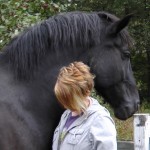
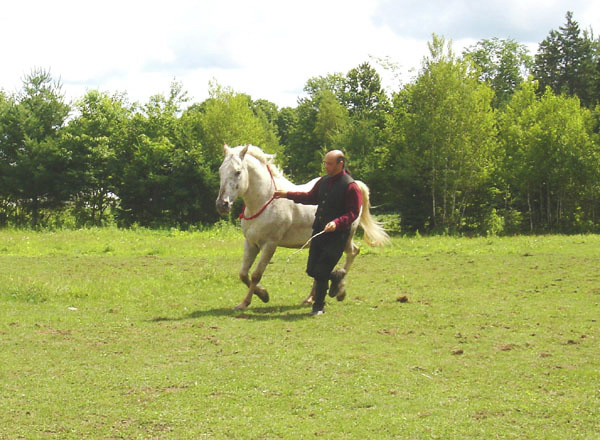
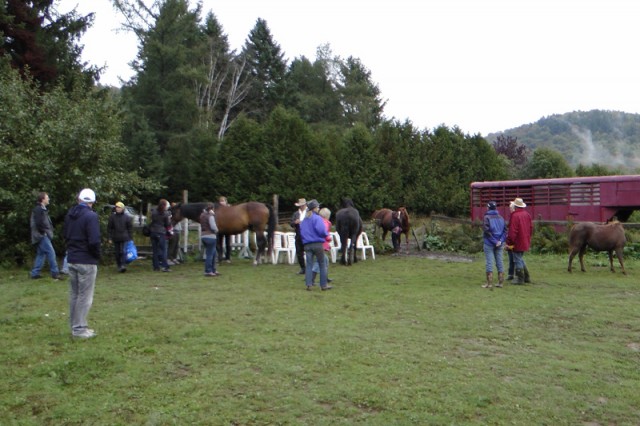
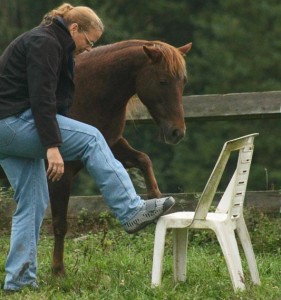
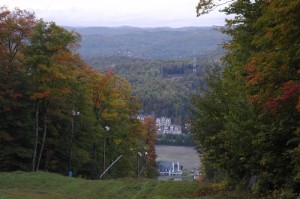
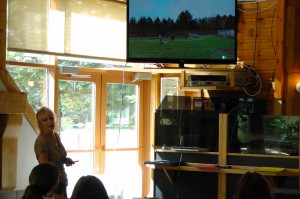
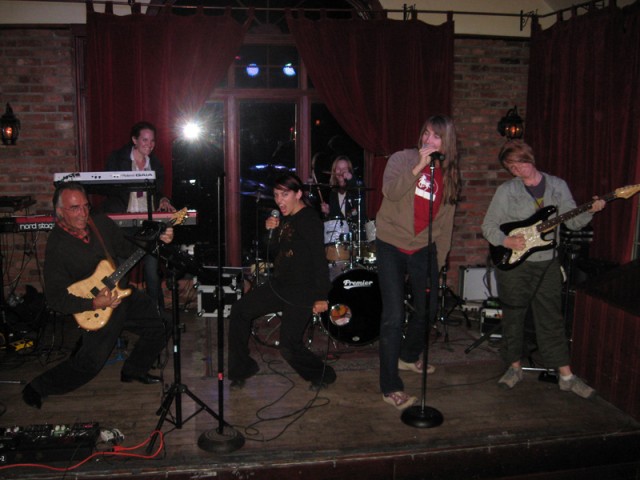



Amazing thanks for sharing
Dear Laraine
Yes, it is pretty amazing stuff and we are now exploring its impact on relations with our horses. More about that in the not too distant future.
Be well!
Andrew
It’s great that you were able to attend. I attended one of his first, if not his first, seminar. It was great, but it was focused so much on Nevzorov. He now has so much more confidence in his own path. he works with his whole herd of horses at home.
We did have a great experience and met many wonderful people.
Thanks for the information on this latest seminar. I hope to be able to attend again sometime.
Anne-Marie Reed
Dear Anne-Marie
We were indeed very fortunate to attend the NHE International Seminar in Quebec.
You are right: Michael Bevilacqua has his own path even though a large part coincides with that of Nevzorov and I personally hope that he will continue to share it with whomever is interested in experiencing it. His is a voice that needs to be heard.
Be well!
Andrew
Dear Andrew & Vicky, that must have been some experience – thanks so much for sharing.
Take care,
Geerteke
Dear Geerteke
You surprise me. If you were going to respond, I thought yours would have been a rather challenging comment. You often cause me to re-examine what I have written. For which my thanks!
Be well!
Andrew
I know, Andrew. Thanks for your comment.
Perhaps I surprised myself even more than I surprised you. For some reason I could not get more ‘on paper’ than this one line.
I did think “why” and “how”. However, I could not find an answer and decided then to let go.
After having read your above response I felt a small urge to do some soul searching. So I did.
The first feeling that surfaced was a feeling of deflated-ness.
But why should I feel deflated? Did I have a reason to experience that feeling?
Sometimes I pick up on other people’s feelings. But whose feeling then. Perhaps your feeling of being tired after the trip back and forth with a very exciting experience at Michael’s place. And this feeling of being tired kind of hiding behind your words.
None of that.
It appeared to be my own feeling.
A feeling completely opposite to being inspired.
But why then does the Haute Ecole (read Michael Bevilacqua) not inspire me?
Is it perhaps because I profoundly miss the spiritual component?
With the ‘spiritual component’ meaning the development of personal awareness. Perhaps the self-realisation.
I experience a kind of sluggishness in my awareness. The sharpness of my mind has left me. That is a signal for me that something in this whole thing is slowing me down.
That is not good for me.
But may be very good for someone else.
I shall leave it here otherwise I am afraid my story might become too much mumbojumbo.
Thanks again and take care.
Geerteke
Dear Geerteke
I feel that I have prodded a contribution from you. Perhaps I should feel guilty but I do not. Your contributions are always welcome, because they stir me to reflection.
Like you, I profoundly miss the ‘spiritual component’ in Nevzorov Haute Ecole. But in Michael Bevilacqua? Clearly I have not been very successful in my efforts to describe the differences between them. Perhaps you should listen to the man himself. He has a couple of books available on his website at http://www.beyondthedreamhorse.ca. I highly recommend them. Alternatively, you can order his book here.
Be well!
Andrew
Andrew said: “This implicit call to humans to rediscover their humanity and place in the natural environment of the horse begs the devotion of attention to the development of the human. Perhaps this is something Michael Bevilacqua may find himself also called upon to devote attention to in the future.”
Yes, Leo, Phantom,Peppy,Primo,Pepper and me we are waiting patiently for Michael to wake up and realize he should not hesitate and create a “Butterfly effect” by branching out of the NHE organization to continue to grow as a Human. We have been there before in the past when Michael was operating under ” Equi-Form” and again he could not see at first the horses telling him to stop giving riding classes. I used to step out of the house and the horses would stop listening to Michael and move towards me (sometimes with a student on their back! Poor things!)
I would like to say to people that what we are experimenting here with are personal horses and nature itself ( I have been getting the cooperation of wild birds this past summer to my great JOY) is much further than what you have come to realize at the Seminar.
You have “rediscover your humanity” but you need to question the “place in nature”
Monica
Dear Monica
At the end of the day we humans can only do what we are ready for. When Michael is ready to take the next step on his path, I imagine that he will do so, whatever it may be.
I can imagine that it must be very challenging for a person commanding so much public respect in the horse world, as Michael Bevilacqua does, to decide what to share with other humans and what not. It is possible for such a public figure to become a purist and refrain from doing many things. The question I then ask is whether by doing so, such a person does not then risk becoming the author of his own irrelevance … to others, to his horses and ultimately to himself.
There is a growing tide of humans around the world who are searching for a new way of being with horses. They are at different stages along the path. Some are just about to make the first step. And they look to those humans for guidance who have publicly shown that there is a better way.
Michael is one of those people. Those who have looked to him for guidance may not have learned everything overnight. Does anyone? Yet I am sure that they have taken something with them, which may grow and lead them to a closer relationship with their horses.
It has taken me five years to get to where I am since I first saw Nezorov and his horses create magic on the ground and in the air. And, to quote Michael, ‘I have ended up where I actually want to start’. What that start will be for Michael is something only he can determine no matter how impatient the rest of us may be. He will act or not act when he is ready. So be it.
You suggest that the rediscovery of one’s humanity is separate from knowing one’s place in nature. I would question whether it is possible to rediscover one’s humanity without learning one’s place in nature.
Take care!
Andrew
Andrew,
I never said that ” the place in nature” was separate from one’s humanity but to “question it” more. Not in a spiritual way but more physically.
Anyway, like you said we can only wait and observe as people will come to these realization in their own time.
For Michael well I learned through his experience to be a “public figure” that people who “turn” to “public figure” should understand the dynamic underlining those people. I was myself a longtime ago briefly a “pubic figure” and people came to me with pens and paper for me to write them a note, they purchased my work,etc… but I found all that very sad as all those people did not believed in themselves and that they too could achieve in life their dreams. So I stopped.
Dear Monica
I hope that just one of those people who came to you to purchase your work and for you to write them a note, will have gone away with a seed that may just have grown unbeknown to you. Perhaps that person did not believe in himself or herself at the time. But what of now? Perhaps you planted something? Perhaps not?
Whatever the case, why find it sad? Was there no joy in it? For you? For them? Did you not derive any joy from what you were sharing? And if you did not, what did you really have to offer those people? But if you did, if for just a moment you did, what then?
Be well!
Andrew
Andrew,
You ask yourself lots of questions here! When you “sell” something the interactions become part of your “marketing plan” meaning the way you will present your work and yourself is to attract the right buyer for your work. At the time, I was experimenting with different type of approach to do so. So in short I can say that the “public figure” approach did not work for me as people did not buy the work because they like it but much more for the idea that perhaps I will become much more known and indeed I was very passionate about my work then and was very sad that people reacted that way.
Yes, quite eye-opening and a lot to think about and act on…
Dear Ian
It is actually also quite challenging as a human to see your horse question your worth, when it is free to wander off as it pleases and it does just that. And when the horse does finally seek you, you know that it means much more than the title of a book.
Be well!
Andrew
Yes, to take a line from your post above, this is all about re-learning ‘one’s place in nature’, isn’t it? Taking time for a healthy, fun loving dialogue to develop with your horse and, yes, tuning into the joy we feel – both horse and human – as sentient beings, experiencing what it is to ‘be’ alive, to share a state of bliss, even in the darkest times.
Dear Ian
Yes, I think you have it. Ultimately, I suppose it is a question of how you would like to relate to your best friend (assuming that your are both alive!), even in the darkest of times.
Take care!
Andrew
Thanks Andrew… we are striving to stay alive and thrive, despite the invasive political and environmental climate.
Dear Andrew,
It was a pleasure meeting you and Vicki, my only regret is that the time spent together was too brief. I must say that you are a good writer, it’s a gift to have the ability to transcript emotions into words, I wish I could. They say good writer are also good storyteller and it’s true, you made me relive a memorable week-end and you also simplify my life because when people ask me how was the seminar I just give them the link of your blog.
Thank you!
Cloé
Oh! I almost forget, the name of the Appaloosa is Shaman.
Dear Cloé
Our time together was indeed too brief. There is so much that I would have liked to speak to you about and I would so much have liked to see you and Thunder spending time together. In the few moments that I caught the two of you together, it was clear to me that you and your horse have a very special relationship with each other.
Thank you for your kind words. There are times though when I would willingly trade my writing skills for the ability to be and to do what I often can only write about.
Thank you for passing on Shaman’s name. The Appaloosa shall no longer remain nameless.
And thank you again for allowing me to share so much with so many horses and humans during that one brief weekend.
Take care!
Andrew
Hi Andrew,
As Cloe said, you have a particularly powerful way with words and brought back the wonder of the weekend to me as well. I so enjoyed meeting you and Vicki and appreciate your unrelenting reminder to live our joy.
Thank you so much,
Ritu
Dear Ritu
Thank you for sharing your joy with me, then and now.
Be well!
Andrew
Brilliant article Andrew. We need you on the path traveling around documenting this shift that is going on between horses and humans around the world. Want to go to South America next? Poland? Germany? Spain? California? We have openings!
Dear Stormy
I know where the praise comes from and I greatly appreciate it.
You are one of the humans whose contribution to horses, humans and the relationship between them is something that I respect and admire. I can still remember Vicki and I organising screenings of your DVD, Path of the Horse, in our home. It made a huge impact … on us, and on our friends and acquaintances. Thank you!
Incidentally, I believe you still have footage of a former NHE seminar organised by Michael Bevilacqua and Cloé Lacroix in Canada. Have you thought about sharing some of it with the rest of us?
And again incidentally, about those openings for documenting this shift that is going on between horses and humans around the world, where do I sign up?
Be well!
Andrew
Dear Andrew
How wonderful to see this article. Thank you for writing it and publish it. It is this little things you play with your horses that bring the joy. On my path with my horses this is exactly what I had to do to overcome my fear of horses. And I found it to be the basis of any interaction with them. The heart just fills with joy.
With my best wishes for you both from Australia.
Dear Petra
It is so very good to hear from you again.
It has taken me five years to get to this post and discover that the secret to a meaningful relationship with a horse revolves around a three-letter word: joy. If you do not have it within you, why would your horse even want to seek you if it truly has a choice?
May the horses in your life continue to be happy and healthy.
Be well!
Andrew
Andrew it was a delightful surprise to see you and Vicki in the photos of the Quebec seminar posted on the NHE Forum and on Michael’s website.
Your descriptions and insights add yet another dimension for those of us who weren’t able to attend. It stirs fond memories for me of past Seminars with Michael and of my own visit with Cloe last May.
Your blog adds a strong and eloquent voice to this movement of true horse-lovers we see worldwide.
I do however find myself disagreeing with some parts of your post. I was quite surprised at first to read a description of NHE so different from my own perception. I hope your readers will like to see an alternate perspective.
I’ll try to keep this brief (difficult for me especially when the ideas are subtle). But I don’t want to hijack your blog with my own story so I’ll just mention one main point that contradicts my own experience:
You wrote:
“If I have understood the Nevzorov approach correctly, it essentially requires us humans to accept that the horse is always right, that we have no right to harm the horse or make it do or desist from doing anything. Instead, we are to accept that the horse is a sentient and physiological being similar to ourselves and that our aim should be to secure the horse’s willing collaboration through communication and understanding. This is underpinned by a sound scientific basis but no attention is devoted to the type of human you need to be in order to achieve this. Rather, the focus is on what you can do to interact with your horse and how to do it, accepting whenever possible what the horse gives naturally.”
I agree with the first part of this. But do you really feel Nevzorov does not require human development? Certainly, the man does not represent himself as a spiritual guru.
Still, though not explicit the spiritual imperative of NHE is very clear, but like all aspects of the school this learning and growth is entirely self-directed. No particular technique or affiliation is recommended, and no proselytizing is tolerated. To quote Lydia Nevzorova, it’s “freedom of conscience”.
“Sangre Fria” or composure is a key concept students of NHE must embrace and it can be difficult to master. To observe and accept emotions without allowing their full expression, to acknowledge ego but not allow it to dictate action, these disciplines require deep reflection and self-awareness.
Here a short selection of quotes from Alexander Nevzorov give an idea of what kind of “inner requisites” the student must acquire by study, discipline and self-development:
“A horse and any kind of sloppiness are completely contradictory. Plus you have serious inner requisites, for example, vegetarianism as an ethical choice (if you work with animals please do not eat them). The Spartans said vegetarianism teaches a man to scorn pleasure. Meat is not a food; it’s just an unnecessary pleasure. If someone seeks pleasure in food, who can guarantee, that he would not do the same with a horse?”
“The stricter the questions a rider asks himself, the better and more properly he can picture the physiological feelings of a horse. The more honest the answers he gives himself – the more effective the process of education will be.”
“It is very hard to understand sometimes, where the School as a spiritual practice ends and when it becomes the art of working with a horse. Both of these parts are associated.”
In short, to imply that NHE focuses on teaching the horse and neglects human development is backwards, to my mind. Educating a horse the NHE way absolutely requires the human to change and develop himself; it’s impossible any other way.
I’ll close with one of my favourite Nevzorov quotes which states one of the NHE mottoes and expresses an idea of science as an inspirational activity:
“I often say, “The horse is an exact science”. Without comprehensive knowledge of equine anatomy, physiology and biomechanics, which should not be formal, or intellectual but “blazing, live, detailed knowledge” even the simplest “work in hand” is impossible.”
This is the kind of idea that lit my fire when I first learned of NHE, and continues to inspire me to the present.
Vicki Reesor
Assistant Dean and Chief Moderator
NHE International School and Forums
Dear Vicki
May I thank you profusely for going to so much effort to read my post and then produce such an eloquent response. I am humbled.
I just have one question for you Vicki, and it is this: When you look into your horse’s eyes, I mean really look and linger in the moment that is always now, do you only see and feel an ‘exact science’ or is there much more, much that is beyond science as we know it?
Take care!
Andrew
Dear Andrew:
I’m glad if what I write is of any value to you and your readers.
What you ask is a very personal question so I will answer it only for myself and not in any official capacity for NHE.
The answer is so simple but Oh Boy so difficult to put into words. Hence the delay in my response.
You ask what I see and feel when I look in my horses’ eyes, and I hope you will not think I’m trying to evade the question when I answer: It depends on the day.
Here I think we get into the realm of belief; I always see what I believe to be there, but what I believe depends on how I have been spending my time.
There’s a connection that comes and goes, depending on how diligently I have been doing my personal work or spiritual practice (which to me are two ways of expressing the same thing).
Some artists I admire can convey it better than I can write it. When I’m out of touch, out of ‘practice’, still I remember the feeling and experience the desire for connection Peter Gabriel sings about here: http://www.youtube.com/watch?v=kU8OJAOMbPg&feature=youtu.be
I can see that light but I can’t touch it. I remember that connection but it’s outside ‘me’; I’m only in duality. And to be honest this is most of the time. But with study and practice, this is changing somewhat.
When I’m faithful to my spiritual practice I spend more time in a state where everything is connected by the same energy, and looking at a screen full of analytical chemistry data or into the eyes of a trusting child or at anything, feels the same. It IS bliss. Alex Grey paints it better than I can write it – he’s an artist who can paint perfectly with anatomical accuracy – but I don’t know of another artist who can paint consciousness the way he does: http://alexgrey.com/art/paintings/soul/bodymind-as-a-vibratory-field-of-energy/
There is no separation between science and feeling when I’m in this state. I AM the data, the child, the dog, the horse. And it’s all Love.
Dear Vicki, thank you so much for sharing Alex Grey’s art. This particular painting impresses me so much that I have put it on my FB page with a referral to the qed-information obtained through a scan using the NES ProVision system. Perfect. Thanks again.
Take care, Geerteke
Dear Vicki
Amen!
It is the development of this type of consciousness that many of us miss in the public approach espoused by Nevzorov and which many find in the one advanced by Michael Bevilacqua or Klaus Ferdinand Hempfling, for example. More importantly, it is what many of us feel is absolutely essential if we wish to have any chance of relating to our horses in any meaningful way.
Thank you so much for sharing this.
Take care!
Andrew